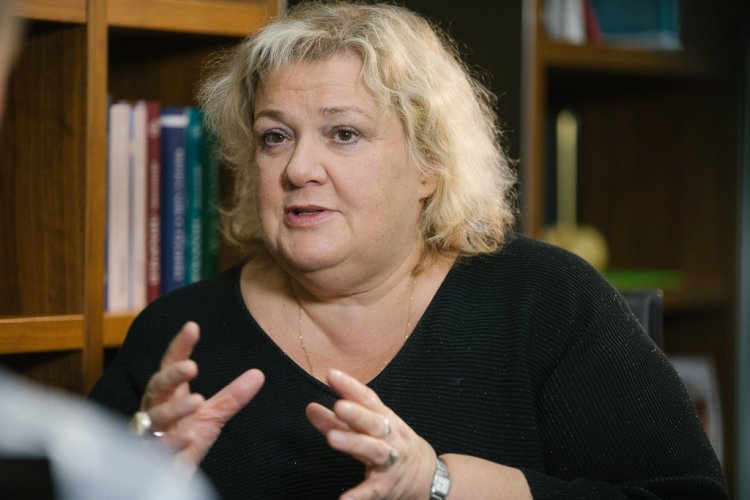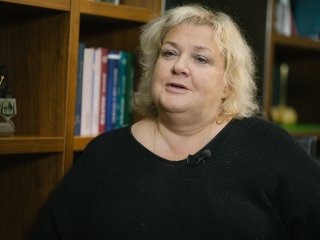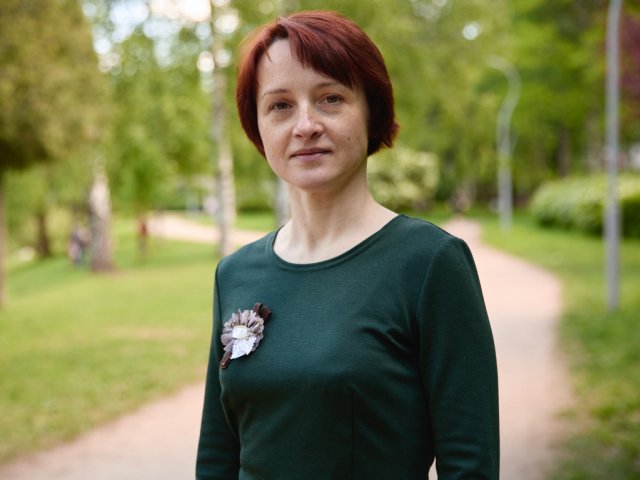“He's a home-lover, he sits by the computer, reads books, and chokes twice a night,” – why you can't turn down treatment for bronchial asthma. “Mom, can I breathe a little more?” – why you can't stop treatment. “The child has been sick every May for five years, but neither the doctors at the clinic nor the parents are interested,” about the importance of early asthma diagnosis.
Interview with Allergist and Pulmonologist Nadezhda Knyazheskaya
Photo: Nikolay Mokhnachev / Scientific Russia
According to various data, about one to five percent of people in Russia have bronchial asthma. And 10-15 percent have a severe form of the disease. Nadezhda Knyazheskaya, Candidate of Medical Sciences, allergologist and pulmonologist, talks about it and gives examples of why it is necessary to treat asthma, and not only to relieve its symptoms; when it is important to make an honest diagnosis; and which modern means of therapy allow asthmatics to live without being dependent on the disease.
– Open sources contain different data on the number of people with bronchial asthma in Russia. There is also quite a wide spread in the information about the number of people who are severely ill. Why do these data vary so much?
– Bronchial asthma is one of the most common diseases. Today there are 300 million people in the world with bronchial asthma, almost seventy percent of them have fairly mild asthma, but the remaining thirty have more serious forms. Ten to seventeen percent of these serious forms are referred to as severe, poorly controlled asthma. It is difficult to achieve good control of the disease with this form, even with the most advanced medications and treatments.
These seventeen percent of patients with asthma are often sick and hospitalized, they call an ambulance, and they incur direct expenses for a large amount of medications, as well as indirect expenses such as sick leave and child care. Children with severe bronchial asthma miss school and kindergarten. In other words, since a large proportion of asthmatic patients are children and adolescents, social problems that arise around the disease are quite serious. Very often bronchial asthma develops and is diagnosed at an early age.
According to official statistics, about one and a half percent of the population in Russia has bronchial asthma. This is an extremely low figure. But in some regions, such as Irkutsk, Moscow, Yekaterinburg and Novosibirsk, serious epidemiological studies have been conducted; these studies revealed about six to eight percent of people with bronchial asthma in these cities.
– If the actual number of people with asthma is higher, what diagnosis is made to people who have asthma but are not counted in the statistics?
– Usually, they are diagnosed with different forms of bronchitis. For example, a person is diagnosed with “chronic obstructive bronchitis,” “asthmatic bronchitis,” “bronchitis with an asthmatic component.” This is a misdiagnosis, most likely these patients have bronchial asthma. There is a diagnosis of “chronic obstructive bronchitis” indeed; however, it has its own specific features and occurs in adults due to exposure to various harmful substances, but most often, due to smoking. Besides, this disease practically does not occur in children.
Sometimes the bronchial asthma is diagnosed at the age of thirty to thirty-five or older. It is considered to be a diagnosis at a late age and sometimes such a patient needs to be treated differently. But it also happens that asthma is diagnosed at forty years of age and the patient has been sick since childhood, merely misdiagnosed. In this case, one should ask such a patient, “How did you go to school?” – “I skipped a lot.” – “And why did you skip?” – “I had a cough. There was no fever or sputum. I was treated with antibiotics, but Eufillin tablets helped me better.”
Another good question is, “How did you run?” Because schoolchildren have to run in P.E. classes. “Could you run long distances?” – “When there were cross-country runs, I tried to avoid it. It was hard for me; I couldn't keep up with my classmates. It was getting sick.” So, a person had been sick since childhood, but these symptoms were ignored and asthma was diagnosed only in adulthood, when the attacks of shortness of breath and choking appeared.
These people should have an allergy checkup and an external respiratory function test to exclude or confirm the asthma diagnosis. Especially if the person has allergies. Almost 99 percent of cases of bronchial asthma in children are related to external allergens – cats, dogs, pollen, and house dust. And if a child has cough and other manifestations of obstruction (wheezing, shortness of breath, difficulty breathing) in addition to allergies, then they are most likely to be asthmatic. Do they make this diagnosis or not? Very often they don't.
I've talked to general practitioners and pediatricians, asking why they don't diagnose asthma if it's obvious. The answer is that they don't want to worry a person with this diagnosis.
– This sounds like incompetence...
– Yes. And sometimes parents oppose such a diagnosis and the doctor may toe the mark.
The interesting thing is that asthma is treated pretty well. If it is diagnosed in time, the person will be free of the disease.
Interview with Allergist and Pulmonologist Nadezhda Knyazheskaya
Photo: Nikolay Mokhnachev / Scientific Russia
– In the neglected cases, when asthma is found at the age of 30-35, is the disease more severe?
– Asthma can start at any age, but it will come in different forms. It can progress in the form of symptoms, exacerbations, but sometimes, very rarely, there can be a persistent and long remission.
For example, in the childhood, boys get sick more often. During puberty (puberty is the process of a young person becoming sexually mature – editor's note) around the age of twelve or thirteen, some patients' asthma becomes less aggressive and sometimes the symptoms almost disappear. Most patients, on the other hand, continue to have the disease. Some colleagues, usually non-specialist allergists and pulmonologists, for some reason think that we should wait until this age and not diagnose it at an early age. This is wrong, you need to diagnose the disease as soon as the symptoms appear. Unfortunately, it is impossible to cure asthma completely, but there are ways to make sure that our patients do not have its symptoms.
I remember a situation involving a man, a professor at Moscow State University. As a child he suffered from bronchial asthma and he had a very severe reaction to cats. He had such severe allergies that he had a reaction even to children in his class who had cats at home. He was diagnosed with bronchial asthma as a child and at the age of 13, went into remission, which lasted until he was forty. Everyone forgot about the asthma and his wife decided to take a cat, which lived in their home for two weeks exactly; the patient was admitted to our ICU with a severe case of asthma. This is an example of a person who has been sick since childhood, then there was a period of remission for a very long time and after dozens of years the disease symptoms reappeared.
– But asthma is not only caused by allergies, what other triggers are there? For example, non-allergic asthma occurs in people at an older age...
– This is true, the reasons for this asthma are not completely known. And it is not known why asthma occurs at all: it is believed that there must be a genetic predisposition to the development of asthma. This means that the etiology of asthma is unknown, but there are genes that are responsible for the disease development. Everyone seems to be genetically predisposed to one disease or another and some are predisposed to bronchial asthma.
Asthma is a disease of civilization. It emerged as a problem in the middle of the twentieth century, when the number of infectious disease epidemics decreased; among other things, it was when people learned how to prevent and treat tuberculosis. We can see that this is the time when chronic diseases, including bronchial asthma, began to emerge and develop rapidly.
Chronic diseases follow a person throughout their life, but a patient may live safely to the old age and die of completely different causes unrelated to their underlying disease. Most of the time, this is the case – asthma is not a fatal disease, although you can die from it, too.
– What is this disease mortality rate?
– This issue is very well studied in a number of countries, including the United Kingdom. The English way of life includes the presence of pets. In Russia, France, Sweden, and America this disease is also studied, but it seems to me that the English are very reverent about asthma, especially because of its allergic manifestations, which disrupt the usual way of life around cats, dogs, horses, etc.
In the United Kingdom, about one hundred and fifty people died of bronchial asthma in 2015. When their specialists analyzed the mortality rate, they found that not only people with severe forms of the disease died of asthma. This prompted the adoption of new clinical guidelines, in which anti-inflammatory therapy with inhaled steroids begins immediately after this diagnosis is made.
– Is it related to the fact that a person with a mild form does not feel anxious, does not get treated sufficiently and neglects the disease?
– The patient may feel anxious but is not treated due to certain reasons. Otherwise, the disease manifests itself as an acute allergic reaction.
For example, there is such a thing as thunderstorm asthma. This is the type of asthma that occurs during grass blossoms and thunderstorms. When it rains heavily, pollen is pulverized and a gust of thunderstorm wind enters the airways of a sensitized person (sensitization – increased sensitivity of the body to foreign substances – editor's note).
A person's first barrier to allergens are the eyes and nose. They are the first to react to the particles. The pollen in heavy rain and wind becomes so fine that it enters the bronchi immediately.
In 2016, about two thousand people in Melbourne fell ill during a thunderstorm. The healthcare system failed to cope with the situation and six people died of asthma. Some of those who experienced severe choking episodes were aware of their allergies, but were not treated, unaware that the disease could strike so suddenly and take on such a severe form.
There was a similar situation in Russia in 2012, when a massive concentration of birch pollen in the air over Moscow was followed by green clouds and the rain with a thunderstorm. In the evening all the streets, sidewalks and cars were covered with yellow mass – pollen. And in the morning the hospital was almost completely packed with the patients who had their first severe attacks of suffocation. Many patients who came to the hospital with asthma had previously had manifestations of seasonal running nose and conjunctivitis, were easily ill with minor reactions to pollen. Most of the patients had not previously been diagnosed with bronchial asthma. Thank God, we had no deaths from asthma and no severe intensive care cases.
It is important to emphasize that many patients with more serious manifestations of seasonal allergy tolerated this high concentration of pollen in the air well. The fact is that, among other things, they were seen by an allergist and treated with allergen-specific immunotherapy. Our message is: if you have any manifestations of the disease, seek medical advice.
Another clinical example. A young man was brought to me for a consultation: he was fourteen or fifteen years old. He developed an allergy to apples, which worried his mother. Very often this type of allergy is associated with an allergy to tree pollen (birch, oak, alder, hazel).
I asked the boy's mother: how does he feel in May? She told me: every May there are respiratory viral infections, which manifest themselves as lacrimation and running nose. The boy coughs, he has difficulty breathing, and the clinic prescribes antibiotics. The child has been sick every May for five years, but neither the doctors at the clinic, nor his mother, were interested in the reason why it was happening in May.
We did an allergy examination and found the young man to be allergic to tree pollen. Apparently, he had been suffering from the rhinoconjunctival form of pollinosis for a long time and was being treated for acute respiratory infections. Perhaps, his cough was a manifestation of a mild form of asthma. But he was referred to a specialized physician only when cross-allergy to apples appeared. At present, the young man is observed by an allergist.
A timely diagnosis is a crucial question, especially for a young person. For example, it can decide whether a young person is eligible for military service or not.
Interview with Allergist and Pulmonologist Nadezhda Knyazheskaya
Photo: Nikolay Mokhnachev / Scientific Russia
Interview with Allergist and Pulmonologist Nadezhda Knyazheskaya
Photo: Nikolay Mokhnachev / Scientific Russia
– Different types of asthma: allergic, non-allergic, infectious: how are they classified and do they differ in severity?
– The disease has been known since the ancient times: asthma was described by the great ancient physician Hippocrates, Homer described a typical asthma attack of one of the heroes in the Iliad. It is known that in Ancient Greece asthmatics were treated in the Asklepions (Asklepion is an ancient Greek temple dedicated to Asclepios, the god of medicine. The buildings were used both for religious and medical purposes – editor's note).
However, the disease did not become a serious problem until the 20th century, when patients became very, very numerous (more than 330 million people at the moment). While studying bronchial asthma, doctors realized that patients were affected differently and in the 30s of the twentieth century they distinguished the main forms of the disease. The asthma that depends on external factors – allergens – was called exogenous or allergic. And the other one, related to some internal causes – endogenous. They also distinguished mixed variants in the presence of allergic (external) and non-allergic (internal) factors.
In 1967, there was a revolution in research related to allergies: everyone understood that there were substances in the blood that reacted to allergens, but it took quite a long time to discover them. Immunoglobulins M and G were already known. But scientists were looking for an immunoglobulin that was responsible for allergies in general and allergic asthma in particular. In 1967, the Japanese couple Kimishige and Teruko Ishizaka, who were working in the United States, discovered immunoglobulin E. Independently from them, the same type of immunoglobulin was discovered by Gunnar Johansson in Sweden in 1968. This research was submitted for the Nobel Prize and gave rise to the formation of allergology as a science.
In the Soviet Union, a group of scientists who dealt specifically with allergology was formed in 1968. First of all, we should remember Andrei Dmitrievich Ado – he was the head of the Department of Pathophysiology of the 2nd MOLGMI named after N.I. Pirogov (now Pirogov Russian National Research Medical University – editor's note) and became the author of textbooks and monographs on allergology. It was the Department of Pathophysiology that formed the first allergology group, which later grew into the Institute of Immunology and the first Departments of Allergology.
Alexander Grigorievich Chuchalin, an academician of the Russian Academy of Sciences, who led the therapeutic and pulmonological departments for many years, and my scientific adviser, believes that, among other things, we were raised on the basis of A. D. Ado's research. It should also be noted that a huge contribution to the modern understanding of bronchial asthma, the introduction of the most modern methods of diagnosis and treatment of bronchial asthma, is primarily associated with the name of A. G. Chuchalin.
It was also very important to understand what allergens are. The house dust mites were only seen through the electron microscope. Since allergens are very small in size, they penetrate the skin, upper and lower respiratory tract, and gastrointestinal tract, causing sensitized people to release immunoglobulin E. There are different classes of allergens: house dust, hair, pet dander and sweat, pollen, mold fungi, etc. But why some people have allergies and others don't is a question of genetics.
Allergists like to say that there is no animal scarier than a cat when it comes to allergy sufferers. The fact is that cute cats also form a pool of immunoglobulin E and it doesn't matter if the cat is furry or bald, because their sweat and saliva cause allergic reactions, too. Sphinxes are just as allergenic as their furry counterparts.
There is also a non-allergic form of bronchial asthma, which is not associated with the production of specific (to one or more types of allergens) immunoglobulin E – the endogenous form. As a rule, this form occurs at a later age and can be associated with past infections, stress, taking certain medications or other, not yet known to us, factors.
The modern classification of bronchial asthma also implies several forms of the disease. In 2014, its definition states that bronchial asthma is a heterogeneous disease, distinguishing allergic and non-allergic forms. And in the non-allergic form there is an eosinophilic variant, associated with a certain type of cells (eosinophils) in the blood and respiratory organs, which are the main “players” of the inflammatory process. Allergic and non-allergic asthma refers to the second type of cellular reactions, it is also called T-2 asthma. But there is also non-T-2 asthma and we know very little about it. But it is also being studied and we, doctors, are waiting for the results of these studies.
In general, the classification is now greatly simplified. The doctor has to answer a simple question: is it an allergic form, which requires a specific treatment approach, or is it non-allergic, which also requires a specific approach. If non-allergic, is it eosinophilic or non-eosinophilic. First of all, this is important for the choice of treatment. But there are also general approaches to treating patients that involve prescribing anti-asthmatic anti-inflammatory drugs, which include inhaled glucocorticosteroids. Why is their use so important in the treatment of asthma?
So, bronchial asthma is a chronic inflammation, which means that it is always present, regardless of whether a person is mildly or severely ill. Asthma is expressed by symptoms such as distant wheezing – those ones that people hear themselves. Asthma symptoms also include coughing, shortness of breath, and tightness in the chest. Patients with asthma also have bronchial hyperresponsiveness, which means that certain substances can cause bronchial constriction and medications reduce airway obstruction. The more pronounced the inflammation is, the more pronounced the disease symptoms are. Choking attacks are typical of the severe disease forms. In most patients with asthma, the airway obstruction is reversible, so it is important to diagnose and treat the disease as early as possible.
– Can a mild form of bronchial asthma become severe?
– It may or may not progress: no one can give an exact answer. It depends on many factors (multifocal problem). But if bronchial asthma is left untreated, the possibility of more severe forms is quite real.
There are some people who have been having mild illnesses for decades. But they can go somewhere, encounter their own allergen or virus and the disease will turn into a severe form. No one can guarantee that if a patient has mild symptoms, they will remain mild for the rest their life. No one can tell you what to do to prevent the severe form. But treating asthma correctly and following the recommendations is very likely to keep the disease from becoming severe. The focus today is on mild and severe asthma. We understand what to do with the majority of patients with the severe disease forms: usually, these are aware people who go to doctors, receive treatment, and understand that if they continue to receive treatment, they will live, study, and work normally.
Preferably, there should be no symptoms of asthma at all. The goal of our treatment is to make exacerbations disappear, to eliminate the need for on-demand medications, and to normalize external respiratory function.
It should be noted that the groups of mild and severe patients are very polar. At the same time, just like everything polar, they have some similarities.
The global strategy to fight asthma focuses on the mild form of asthma. The major problem with asthma is that it is difficult to diagnose. It is important to diagnose and understand how to treat the patient in time. There can be difficulties because the patient can think that they have a mild form of asthma. Naturally, the disease brings certain discomfort and patients are drawn to medications that alleviate these symptoms. These are sympathomimetics or quick-acting bronchodilators – the person inhales them and feels free. Often such a person does not go to the doctors, but consults the pharmacist at the pharmacy, relatives, and friends. The consequences of such consultations can be disastrous and the patient is forced to call an ambulance for choking. Sadly, it is the ambulance doctor who becomes the first specialist to diagnose bronchial asthma.
Today, the world is moving away from the treatment choice of taking respiratory medications only. Even if a person gets mildly ill, a morphological change has already begun and it requires the prescription of anti-inflammatory inhalation hormones. There is already inflammation within the bronchial tree and anti-inflammatory medications must be used. Once again, the main anti-inflammatory drugs for asthma are inhaled glucocorticosteroids or inhaled hormones. When mankind invented them, the lives of people with asthma changed dramatically.
Patients often state that they don't want to take hormones and sometimes it's very difficult to convince a person to be treated this way. I have an outrageous case in my practice.
A mother with a ten-year-old child shows up. The boy wakes up twice a night, but she wouldn't give him inhaled steroids at all. The child does not go to school, cannot play with his peers, is incapable of any physical activity: he is a home-lover, he sits by the computer, reads books, does not go anywhere, and occasionally suffocates. When he feels really bad, he is given inhalers, which make it easier for him to breathe.
I say that it is necessary to give inhaled hormones together with long-acting beta 2 agonists – that is the modern treatment. The mother says that she won't let her child be treated that way, she thinks it's harmful. I ask, “Do you have any special knowledge, since you take such responsibility?” – “Yes, I've read the literature and I don't think he should be treated that way.” It is likely that the “literature” she read is some fake stuff on the Internet.
I realized that I had to help the child: he was totally dependent on someone else's will, he could not choose whether or not to suffocate on his own. His mother decided that he would choke every night instead. The mother says, “I don't sleep either.” But that's her choice. And there is an alternative – both the child and the mother can sleep soundly. He can go to school and socialize with his peers, but he is limited in his ability to live differently. Eventually, the woman was persuaded. The boy started taking treatment and went to school two months later.
Another situation: an adolescent doctor sent a 16-year-old child. We chose a treatment for him: at first his mother was also against it, but the case was too severe, so she agreed. Two months later they come for a consultation, the young man's symptoms have disappeared, his external respiratory function has increased, another life has begun. The mother says, “Can we stop the treatment already?” and the son turns to her and says, “Mom, can I breathe a little more?”
Modern therapy provides great opportunities for the treatment of bronchial asthma. Patients with a mild form are given an inhaler that contains an inhalation hormone and a fast-acting sympathomimetic. The person takes the drug situationally, when experiencing breathing problems: it both helps breathing and provides an inhaled steroid that suppresses inflammation. The effect is the same as if they were prescribed regular hormones in low doses, except there is no need to take the drug in the morning and evening. The difference is obvious – taking it twice a day or once or thrice a week.
If a person needs these inhalations more often, for example, every day, it is no longer a mild form of asthma and the patient should be transferred to another therapy. But low doses of inhaled hormones are always needed.
A few more words about glucocorticosteroids. They were invented in the 1930s. In the 40s they were already used in practice; prednisolone was mainly used for rheumatoid arthritis patients. And the same hormones began to be used to treat asthma patients. Patients began to think that prednisolone is only used in extreme cases of bronchial asthma and once you start taking it, it's hard to reverse it. That was really the case, so I think the cautious attitude of patients towards this group of drugs has remained since the 50s and 60s. But things have changed radically.
The first inhaled and topical forms were invented in 1972 – these are the hormones that are either applied to the skin, inhaled into the bronchi, or injected into the nose. The paradox is that people are not afraid to dab hormones on their skin, but are very afraid to inhale them, even though the absorption area through the skin is higher than the doses used when inhaled.
So, mankind has received microdose drugs, which suppress inflammation in the bronchial tract with almost no side effects. In other words, this is a purely local treatment and, if you start it in time, the doses will not cause any negative effects. But if a person refuses treatment and starts taking drugs that relieve symptoms, there is a possibility of being admitted to a hospital or even intensive care unit, which uses more severe hormonal therapy with tablets and intravenous forms of these drugs.
There are drugs that target other parts of the inflammation in asthma – these are leukotriene receptor antagonists. They are also used in the treatment of both pediatric and adult asthma, but they have fewer anti-inflammatory properties than inhaled hormones. The doctor may add them for certain forms of asthma to improve disease control.
Achieving control is the most important thing in asthma treatment. In the ideal case, to achieve control is to have a person with asthma who is not dependent on it. If there are no symptoms and no exacerbations, normal external respiratory function – then we can say that the person has achieved full control, but in order to achieve it, first and foremost, one must take a medication therapy.
– Do most asthmatics control the disease?
– No. Only about 30 percent of patients are able to control the process. To some extent it depends on the patient's awareness, because we have to establish a contact with the patient, as we do in the treatment of any chronic disease.
When we prescribe asthma medications, some patients ask, “How long should I take it for?” Maybe for a lifetime. Or maybe, let's dream, there will be treatments that allow us to say, “We've cured the patient.”
– Can't you say it now?
– The disease is still considered incurable, but there are some early signs, though small ones. Recently, we have finished an article on the possibility of a disease-modifying therapy for asthma. As we know, bronchial asthma restructures a person's bronchi. They become more rigid: stiff, they gain muscle mass and the degree of effective epithelium decreases. The wide lumen in the bronchi becomes constricted.
These constricted bronchi produce sputum, which is difficult to cough up. In milder cases, in the absence of severe attacks of suffocation, asthma is treated as bronchiolitis and doctors prescribe expectorants. However, a person is unable to spit up this sputum: the bronchi look like an hourglass and it does not come out easily. The goal is not to spit up the sputum, but to prescribe a treatment that relieves the inflammation and widens the bronchi lumen. We have talked about this before.
The bronchi are dilated with bronchodilators and inflammation is suppressed with inhaled hormones. In the later stages, doctors add cholinolytics.
The possibility of changing the disease morphology was first considered after the appearance of genetically engineered drugs for the treatment of bronchial asthma. These immunobiological drugs are already available on the market and we use them to treat severe patients.
– So far, can't you say that a certain person has been cured of asthma?
– Not yet, but sometimes we, and even pediatricians, ask ourselves such questions. For example, a child with severe asthma begins to be treated with genetically engineered drugs.
When the patient turns 18, he comes to us, the internists. We check the function of external respiration and see that it is absolutely normal, there are no disease symptoms. So, the question arises: is such a patient sick or maybe he has been cured? He takes low doses of basic medications and has no symptoms. The question is: “Is he sick?” – “He is. But he has been treated, the disease no longer interferes with his life and he is on low-dose supportive therapy.” Whether this effect will persist after this biological therapy is discontinued – we cannot answer for sure yet.
There are also international statistics on pregnant women who gave birth to children while being treated with this drug. Today the children born to these patients are being monitored to see how their life will go, whether they will have asthma in the same percentage as patients with asthma without this type of therapy.
– No side effects so far?
– Every drug and even food product has side effects, but reproduction is not affected by this medication. If a woman doesn't want to be treated with this drug during pregnancy, we don't force her. But if she agrees, we continue treatment because it provides a higher level of safety.
– For how long has this medication been in use?
– I've been familiar with this drug for more than 20 years. Thanks to Alexander Grigorievich Chuchalin, we participated in international clinical trials, in which patients with severe allergic asthma received this drug. It was a very large international work with many countries involved. Our work was recognized as one of the best and A. G. Chuchalin is the second author in the publication of this study. The first is Steven Holgate, who organized this work. The fact that A. G. Chuchalin is the second author is a recognition that Russia was one of the leading countries to conduct this clinical trial.
– What are the conditions for using this medication?
– Severe allergic asthma. When the alternative is either very high doses of inhaled glucocorticosteroids or the hormones that need to be taken systemically – prednisolone: its use is associated with some complications of hormonal therapy, yet it is difficult to achieve asthma control with it.
In the last 3 years, we have had other groups of immunobiological drugs: they are suitable for both allergic asthma and non-allergic eosinophilic asthma. These are three drugs that affect interleukin-5. This interleukin induces inflammation by eosinophils and the introduction of anti-interleukin-5 drugs aborts eosinophilic inflammation.
There is a drug called anti-interleukin 4-13. This is a biological drug that is suitable for the treatment of allergic and non-allergic bronchial asthma, too. Interleukin-4 induces allergic reactions and interleukin-13 rebuilds the bronchi. It is exactly the inflammatory link that is affected by the drug.
– Have you been using it for about three years?
– Yes, we have been treating these patients for about three years. And, on the whole, we are satisfied with all five drugs. And the indications for their use are expanding.
Besides asthma, anti-interleukin-4-13 is also registered for the treatment of such a severe disease as atopic dermatitis. I don't know which brings more suffering to a person: asthma or atopic dermatitis. People have rashes, even on the face, that itch all the time, no matter what they eat. Sometimes the disease takes a generalized form. And after taking the drug, the person literally gets cleansed by the minute. This is a miracle.
I have a patient with moderate asthma and a very severe form of atopic dermatitis. She couldn't work because of the disease, she couldn't sleep at night because of the itching. It was very difficult to talk to such a person: a very nervous, aggressive woman.
We were treating this patient for a year and I didn't recognize her when she came in to renew her treatment: a person with perfectly healthy skin came in. She told me that she was eating oysters. It's not her first need, of course, but it's important for her to be able to taste them. Moreover, she felt so good about not feeling sick anymore that she got married. And previously her whole life had been associated with illness.
– So now we can say that people with asthma, after receiving appropriate treatment, can live a full life, right?
– Today, all drugs make it possible to achieve control. It is not necessary to use immunobiological drugs for this purpose. The main thing is that the patient should receive adequate treatment at any degree of severity. In certain cases, it is necessary to add expensive treatment with biological drugs: thanks to healthcare organizers, it has become more available. Thanks to RAS Academician A. G. Chuchalin all asthma patients have been receiving free treatment since 1985.
– Is biological therapy included in the CHI?
– Yes, it is included in the CHI.
– After your stories from medical practice, I have the impression that much of the asthma problem in Russia stems from the reluctance of patients to accept the diagnosis and treatment...
– This is not the only problem. Many people are willing to be treated and take medications. The problem is multifaceted.
First of all, it is a matter of training primary care physicians – general practitioners. And it's a question of training students at universities, because not too much attention is paid to asthma, although it's a very common disease. I think that there are very few asthma specialists.
In addition, there are some constraints, too, such as a limit of 10 to 15 minutes per patient. That is very little for a primary patient; sometimes we have to talk to the patient. In the course of the conversation, we can find out what prevents patients with asthma from living a normal life. We need to check the inhalation technique. All these things will contribute to proper treatment.
Bronchial asthma is not just a patient problem. It is a problem of schools, universities, and society as a whole. Society needs to be prepared for the fact that there are asthma patients. For example, diabetes mellitus is treated more “sensibly.” We tell patients: “If you get sick on the subway, you need to get an inhaler and inhale the medicine.” They tell us that when they take out their inhalers, there is a void around them. At the same time, patients who cough in a cafe or theater are generally shunned. As a result, asthmatics are embarrassed about their disease.
– What advice would you give to people with asthma or those who suspect they have the disease?
– It is necessary to see a specialist. First of all, allergists and pulmonologists. It is not so easy to address them now, first you have to go to a general practitioner. Patients have to tell us in detail what they are worried about and ask to be referred to a specialized center, where they will get an accurate diagnosis. Depending on the results of the examination we will prescribe the most effective treatment: from small doses of medication to immunobiological therapy. And patients can live their lives free of the disease by taking an uncomplicated treatment.
Just as an example of normal life: there are a lot of asthmatics among Olympic athletes, for example. They get certificates that allow them to take medication, get treatment, and compete. There are also a lot of them because progressive parents think that if a child is sick, they should be put into sports to make them healthier. It's doesn't always help, but sometimes it does. I'm always in favor of our patients going to fitness clubs and doing jogging and walking. But it is possible and necessary to apply the appropriate treatment.































